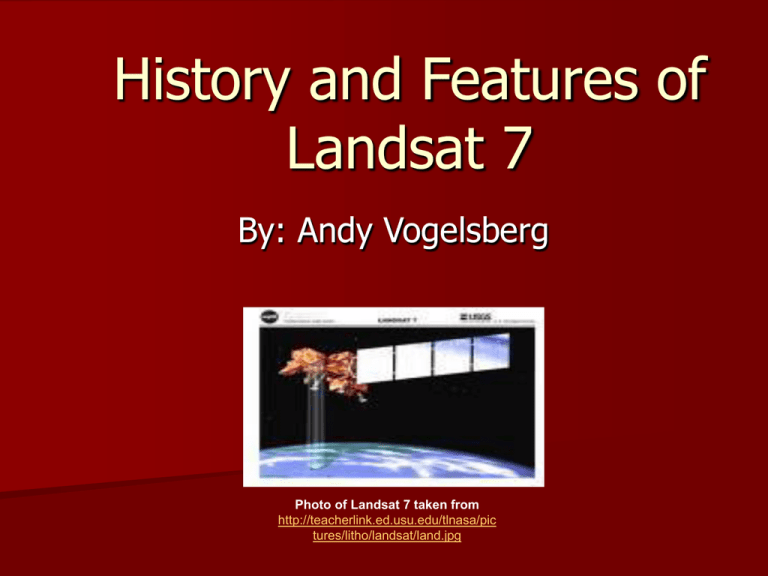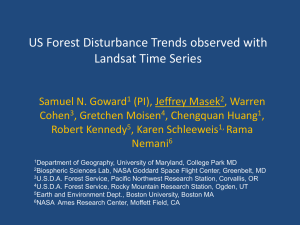History and Features of Landsat 7
advertisement

History and Features of Landsat 7 By: Andy Vogelsberg Photo of Landsat 7 taken from http://teacherlink.ed.usu.edu/tlnasa/pic tures/litho/landsat/land.jpg History of Landsat Program The Landsat program was inspired by Apollo moon bound missions. William Pecora proposed the idea of having remote sensing satellites in space in 1964. Eight years later, his proposal became reality, and the Landsat program had begun. Landsat 1 was launched on July 23, 1972. Since then, six other satellites have been launched. Landsat 7 is the most recent satellite we have launched, providing us the most technological data possible. Landsat 7 Landsat 7 was launched on April 15, 1999 from Vandenberg Air Force Base in California and was built to last at least 5 years. The purpose of Landsat 7 is to replicate the capabilities of other launches, as well as provide new information. Landsat 7 can provide more information than any of the previous Landsat satellites at a lower cost. 532 images a day can be produced by Landsat 7. Landsat 7 orbits the earth at an altitude of 705 Kilometers and covers a swath width of 185 km. The satellite covers the whole earth in 15 days or 232 orbits. Landsat 7 weighs 1973 kg. The observing instrument on board Landsat 7 is the Enhanced Thematic Mapper Plus (ETM+). Enhanced Thematic Mapper Plus (ETM+) The ETM+ was also used on Landsats 4 and 5. Landsat 7’s ETM+ has features that other satellites did not. These features make Landsat 7 a more useful component for studies in global change, monitoring of land cover, and mapping large areas. Image of Landsat 7 ETM+ taken from: http://landsat.usgs.gov/project_facts/history/images/ETM+instrument.jpg Components of Landsat 7 A drawing of Landsat 7 taken from: http://directory.eoportal.org/images/LS7_Auto4.jpeg Advantages of Landsat 7’s ETM+ Landsat 7’s ETM+ is different from previous thematic mappers because it offers: a panchromatic band with 15m spatial resolution on-board, full aperture, 5% absolute radiometric calibration a thermal IR channel with 60m spatial resolution an on-board data recorder (Bulleted data taken directly from http://landsat.gsfc.nasa.gov/about/landsat7.html) Malfunction on Landsat 7 On May 31, 2003 Landsat 7 experienced its first problems. The Scan Line Protector (SLC) on board Landsat 7 failed. The problem created narrow bands on images formed by Landsat 7 to be missing. These narrow bands were caused because image scanning in the SLC was at an angle instead of being parallel. To this day, the malfunction of the SLC is still affecting images acquired by the satellite. Landsat 7 loses approximately 22% on each image it acquires because the SLC is not operable. Methods are being done by the USGS to duplicate all missing data due to the malfunction of the SLC. Affects of No SLC The SLC’s job was to compensate for the forward motion of Landsat 7. Without it, a zig zag motion is created. (bottom left) The photo on the right shows the affected area created without no SLC. Images taken from http://landsat.usgs.gov/data_products/slc_off_data_products/slc_off_background.php Major Advantages of Landsat 7 Landsat 7 continues to give us high-quality data with the ETM+ which dates back to Landsat 4 in 1982. Since data looks similar, global change is easy to detect from pre-existing archives. Data acquisition is optimum, because Landsat 7 takes all photos in sun lit conditions. Information from NOAA is also used to keep images cloud cover minimal. Landsat 7 can obtain and store more data faster than any other form of remote sensing instrument. The data collected by the satellite is easy to get through the USGS or EROS at an affordable price. The Landsat 7's ETM+ has been called "the most stable, best characterized Earth observation instrument ever placed in orbit." (Taken from http://landsat.gsfc.nasa.gov/about/landsat7.html) Landsat 7’s ETM+ has also set the standard on accuracy for all other remote sensing systems. The ground accuracy acquired through Landsat 7’s data is second to none. Controllers of Landsat 7 The Flight Operations Team (FOT) is in charge of command control as well as telemetry operations for Landsat 7. All controls of the sattelite take place in the Mission Operation Center in the Goddard Space Flight Center which is located in Greenbelt Maryland. Data is captured from the sattelite in both Sioux Falls SD, as well as Alice Springs Australia. Backup sites are also located in Poker Flat Alaska and Svalbard Norway. Mission Operations Center http://ls7pm3.gsfc.nasa.gov/mainpage.html http://ls7pm3.gsfc.nasa.gov/mainpage.html Images Taken by Landsat 7 Top Left: Cap Canaveral Launching Site Middle: Flooding in South Africa Top Right: Flooding in New Orleans due to Hurricane Katrina medias.obs-mip.fr/.../en/systemes/landsat.html landsat.usgs.gov/gallery/detail/411/ gisdata.usgs.net/.../categories.asp?catid=10 Composite Images of Landsat 7 Left Image: True Color Composite (Bands 321) Middle Image: Near Infrared Composite (Bands 432) Right Image: Short-wave Infrared Composite (Bands 742) chesapeake.towson.edu/data/all_composite.asp References National Aeronautics and Space Administration, Landsat 7, World Wide Web URL: http://landsat.gsfc.nasa.gov/about/landsat7.html Wikipedia, The Free Encyclopedia, Landsat 7, World Wide Web URL: http://en.wikipedia.org/wiki/Landsat_7 National Aeronautics and Space Administration, Landsat 7 Science Data Users Handbook, World Wide Web URL: http://landsathandbook.gsfc.nasa.gov/handbook.html National Aeronautics and Space Administration, SLC-off Products: Background, World Wide Web URL: http://landsat.usgs.gov/data_products/slc_off_data_products/slc_off_background.p hp Landsat 7, Supplying data users worldwide with low cost, multi-purpose, land remote sensing data into the next century, World Wide Web URL: http://geo.arc.nasa.gov/sge/landsat/l7.html Landsat 7 Home Page, World Wide Web URL: http://ls7pm3.gsfc.nasa.gov/mainpage.html









